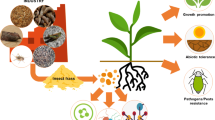Summary
The development and survival of gypsy moth (Lymantria dispar) larvae is strongly influenced by the host plant upon which they feed. The most rapid development and largest pupae were produced from grey birch fed larvae. Beech and maple-fed larvae produced the smallest pupae while maple-fed larvae exhibited prolonged development. White and red oak-fed larvae exhibited development and pupal weights intermediate between the above two groups. The approximate digestibility (AD) and efficiencies of conversion of food (ECD and ECI) were generally highest among grey birchfed individuals. The utilization of the relatively closely related oak species, as reflected in AD and ECD values, differed.
Leaves were examined for 14 elements. The content of each element varied among host plant species and over time. For example, nitrogen levels were highest in grey-birch and dropped over time in all host plants.
Similar content being viewed by others
References
Association of Official Analytical Chemists (AOAC). Official Methods of Analysis. 12th ed. p. 15 (2.049). AOAC Washington, D.C. (1975)
Barbosa, P., Capinera, J.L.: The influence of food types in the developmental structure of laboratory populations of the Gyspy Moth, Porthetria dispar (L.). Can. J. Zool. 55, 1424–1429 (1977)
Barbosa, P., Cranshaw, W., Harrington, E.: Host plant preferences and the induction of preference in larval gypsy moths, Lymantria dispar. Entomol. Exp. et Appl. (in press).
Capinera, J.L., Barbosa, P.: Influence of natural diets and density on gypsy moth egg mass characteristics. Can. Entomol. 109, 1313–1318 (1977)
Christensen, R.E., Beckman, R.M., Bridsall, J.J.: Some mineral elements of commercial spices and herbs as determined by direct reading emission spectroscopy. J. A.O.A.C. 51, 1003–1009 (1968)
Clement, G.E., Munro, W.: Control of the gypsy moth by forest management, U.S. Bur. Ent. Bull. 484, 54 pp. (1917)
Dadd, R.H.: Arthropod Nutrition. Chemical Zoology V. Arthropoda Part A (Florkin, M. and Scheer, B.T. eds.), pp. 35–95. New York: Academic Press 1970
Doskotch, R.W., Odell, T.M., Godwin, P.A.: Feeding responses of gypsy moth larvae, Lymantria dispar to extracts of plant leaves. Environ. Entomol. 6, 563–568 (1977)
Hough, J.A., Pimentel, D.: Influence of host foliage on development, survival and fecundity of the gypsy moth. Environ. Ent. 7, 97–102 (1978)
Leonard, D.E.: Recent development in ecology and control of the gypsy moth. Ann. Rev. Ent. 19, 197–229 (1974)
Maxwell, F.G.: Host plant resistance to insects — Nutritional and pest management relationships. In. Insect and Mite Nutrition. (Rodriquez, J.G. ed.), pp. 599–609. Amsterdam: North Holland Pub. Co. 1972
Mosher, F.H.: Food plants of the gypsy moth in America. USDA Bull. No. 250, 39 p. (1915)
Mosher, F.G., Webber, R.T.: The relation of variation in the number of larval stages to sex development in the gipsy moth (sic). J. Econ. Ent. 7, 368–373 (1914)
Schroeder, L.: Energy budget of larvae of Hyalophora cecropia (Lepidoptera) fed Acer negundo. Oikos 22, 256–259 (1971)
Schroeder, L.: Energy budget of cercropia moths, Platysamia ceropia (Lepidoptera: Saturniidae) fed lilac leaves. Ann. Ent. Soc. Am. 65, 367–372 (1972)
Schroeder, L.: Energy budget of the larvae of the moth Pachysphinx modesta. Oikos 24, 278–281 (1973)
Schroeder, L.: Effect of food deprivation on the efficiency of utilization of dry matter, energy and nitrogen by larvae of the cherry scallop moth Calocalpe undulata. Ann. Ent. Soc. Am. 69, 55–58 (1976)
Sriber, J.M.: Comparative nutritional ecology of herbivorous insects. Generalized and specialized feeding strategies in the Papilionidae and Saturniidae (Lepidoptera). Ph.D. Thesis 289 pp., Ithaca: Cornell University, N.Y. 1975
Scriber, J.M.: Limiting effects of low leaf-water content on the nitrogen utilization, energy budget, and larval growth of Hyalophora cecropia (Lepidoptera: Saturniidae). (Oecologia (Berl.) 28, 269–287 (1977)
Waldbauer, G.P.: The consumption and utilization of food by insects. Adv. Insect Physiol. 5, 229–289 (1968)
Author information
Authors and Affiliations
Additional information
Lepidoptera: Lymantriidae
Paper No. 2277 Massachusetts Agricultural Experiment Station, University of Massachusetts at Amherst, MA U.S.A. This research supported (in part) from Experiment Station Project No. 437
Rights and permissions
About this article
Cite this article
Barbosa, P., Greenblatt, J. Suitability, digestibility and assimilation of various host plants of the gypsy moth Lymantria dispar L.. Oecologia 43, 111–119 (1979). https://doi.org/10.1007/BF00346676
Received:
Issue Date:
DOI: https://doi.org/10.1007/BF00346676




